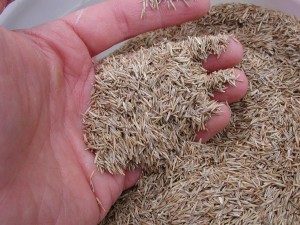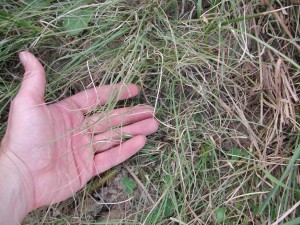
“No mow” grass seed is a mixture of fine fescues that creates a slow growing lawn. (photo/Fred Meyer, Backyard Abundance)
IOWA CITY – It sounds almost too good to be true: a beautiful, natural lawn that doesn’t need chemicals to maintain and even more remarkably, doesn’t require mowing.
Fred Meyer of Iowa City was on board with a “no mow” lawn for all of those reasons.
“It’s been an interesting experiment,” Meyer said of the lawn he established at his new home in the fall of 2011.
Director of the non-profit, Iowa City-based Backyard Abundance, Meyer is inspired by atypical uses for yards, but one of his reasons for growing a no mow lawn was basic: he didn’t want to mow.
“With no mow, I let it go for as long as I want to let it go,” he said.
Meyer used two types of grasses in different areas surrounding his home.
One is a mixture of fine fescue, which has become the standard for no mow lawns. The other is buffalo grass, a low-growing variety native to North America that Meyer said performed well in last year’s drought.
“Without any water, the buffalo grass kept growing and growing and growing,” he said of the grass, which spreads by above-ground stems called stolons. “In a drought, when it’s hot, it looks just great.”
The fine fescues also have a pretty appearance, depending on the eye of the beholder.
His wife wasn’t as keen to the look of the lawn, which Meyer described as “a little lumpy.”
“It looks like a mini meadow,” he said. “It’s definitely a different look than your traditional lawn. I think it’s gorgeous.”
The fine fescues are seeded in the fall, just like traditional grass seed.
Meyer said it’s important to plant into clean soil. Overseeding into an established lawn won’t work, so turf grass must be removed or killed first.
One technique to do so is by smothering the lawn with cardboard covered with mulch.
Even with a clean slate, homeowners should be vigilant about weeds in their new lawn.
No mow lawns are slow-growing; a mixed bag when it comes to maintenance.
While the need for mowing is negated or at least lessened, the slow growth allows weeds to become established.
Meyer said plants that normally would be cut down during mowing sprouted and gained a foothold when he didn’t mow.
A neighboring silver maple also created a challenge when it dropped hundreds of seeds onto the lawn.
To prevent those tiny trees from becoming established, Meyer decided to mow last summer; one of three times that he made the choice. The other two were because of weeds, but that compares to a typical mowing schedule of every 10 days or so.
“I’ll take those problems any day over dragging that mower out,” he said. “I’d never plant a regular lawn again.”

Buffalo grass is native to North America, grows only about 6 inches tall and is drought-tolerant. (photo/Fred Meyer, Backyard Abundance)
FYI
You can learn more about “no mow” lawns during the Spring Home and Gardening Gala, hosted by Backyard Abundance, the Johnson County Master Gardeners and their partners.
The event is 9 a.m. to 4 p.m. Saturday, March 23, 2013, at the Johnson County Fairgrounds Extension Building, 4265 Oak Crest Hill Rd SE, Iowa City. (See events calendar tab, above.)
Here is more about the gala:
A variety of classes show attendees how to save money, energy and time by creating a beautiful home and garden that work harmoniously together. Ten classes are offered:
· Establish a “no mow” lawn
· Plants for problem areas
· Create a wildlife habitat
· Create a butterfly and hummingbird garden
· Permaculture for low-maintenance, pest-free landscapes
· Green houses to extend the growing season
· Rain gardens for storm water management
· Create an indoor worm bin
· Willow in the garden
· Keep trees healthy
“Over 60 people attended the launch of this annual event last year which nearly put us over capacity,” said Fred Meyer, Master Gardener and director of Backyard Abundance. “We expect a similar turnout this year and encourage people to register early to reserve their spot.”
Presenters include green thumbs from the Master Gardeners, Earl May Nursery and Backyard Abundance. Other partners include New Pioneer Food Co-op and the Johnson County Extension Office.
The cost is $25 if registered by March 18 and $30 after March 18 or at the door. Access to all classes and handouts are provided. Lunch is provided by Trumpet Blossom Café for a small extra fee.
For more information and to register, visit the Backyard Abundance website at http://www.BackyardAbundance.org or call 319-325-6810.
Backyard Abundance is an Iowa City-based nonprofit that helps build vibrant communities by creating beautiful, resilient landscapes that provide healthy food and habitat.

No Comments Yet